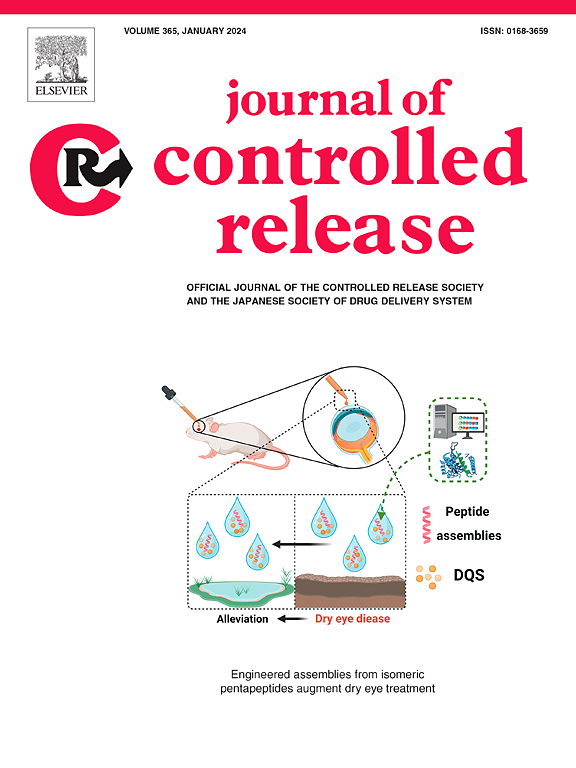High-resolution imaging reveals a cascade of interconnected cellular bioeffects differentiating the long-term fates of sonoporated cells
IF 10.5
1区 医学
Q1 CHEMISTRY, MULTIDISCIPLINARY
引用次数: 0
Abstract
Low-intensity ultrasound combined with microbubbles is a promising, non-invasive treatment strategy for enhancing vascular permeability and targeted intracellular drug or gene delivery. Following ultrasound insonification, cells can undergo reversible sonoporation, involving adaptation and recovery, or irreversible sonoporation, marked by a loss of cell viability. To design effective sonoporation-based therapeutic delivery strategies, it is critical to identify the biological responses that determine these distinct cell fates. Here, we developed a custom-built high-resolution multicolour imaging device and applied a single pulse of ultrasound (267 kHz frequency, 20 μs duration, and ∼110 kPa peak negative pressure) to trigger targeted microbubble-mediated reversible and irreversible sonoporation events within a confluent monolayer of cultured Madin-Darby canine kidney (MDCK) II cells. We found that intracellular calcium levels rose rapidly and peaked within 10 s in both types of sonoporated cells, although the levels declined differently. In reversibly sonoporated cells, these levels gradually returned to baseline, whereas in irreversibly sonoporated cells, they dropped rapidly, falling well below baseline within 7.9 ± 3.0 min (mean ± s.d.). Using single-vesicle imaging, we further found that vesicles containing the tight junction protein claudin-5 remained mobile with subtly reduced movement in reversibly sonoporated cells, whereas they almost stalled in irreversibly sonoporated cells. The underlying microtubule network was partially disrupted in the reversibly sonoporated cells, recovering fully within 3.2 ± 2.9 min (mean ± s.d.). In contrast, in irreversibly sonoporated cells, the entire microtubule network collapsed within 4.0 ± 2.4 min (mean ± s.d.). Whilst in reversibly sonoporated cells, the uptake of the model drug propidium iodide was mild-to-moderate, without drastic cell size changes up to about 1 h post-sonication, irreversibly sonoporated cells presented with substantially higher propidium iodide uptake and completely shrank within 43.2 ± 10.5 min (mean ± s.d.). Together, our study identified distinct spatiotemporal sequences of interconnected biological responses underlying the different fates of sonoporated cells, providing a framework for identifying processes that could be manipulated for safe and effective sonoporation-based drug delivery.


高分辨率成像揭示了一系列相互关联的细胞生物效应,这些生物效应区分了声孔细胞的长期命运
低强度超声结合微泡是一种很有前途的非侵入性治疗策略,可以增强血管通透性和靶向细胞内药物或基因递送。超声失聪后,细胞可以经历可逆的声穿孔,包括适应和恢复,或不可逆的声穿孔,以细胞活力的丧失为标志。因此,为了设计有效的基于超声的治疗递送策略,确定决定这些不同细胞命运的生物反应是至关重要的。在这里,我们开发了一种定制的高分辨率多色成像设备,并应用单脉冲超声(267 kHz频率,20 μs持续时间, ~ 110 kPa峰值负压)在培养的Madin-Darby犬肾(MDCK) II细胞的融合单层内触发靶向微泡介导的可逆和不可逆声穿孔事件。我们发现细胞内钙水平迅速上升,并在10 s内达到峰值,尽管两种类型的超声细胞的水平下降不同。在可逆声波传导细胞中,这些水平逐渐恢复到基线水平,而在不可逆声波传导细胞中,它们迅速下降,在7.9 ± 3.0 min内远低于基线水平(平均 ± s.d)。通过单囊泡成像,我们进一步发现含有紧密连接蛋白claudin-5的囊泡在可逆超声共振细胞中保持移动,但运动略有减少,而在不可逆超声共振细胞中几乎停滞。在可逆超声细胞中,底层微管网络被部分破坏,在3.2 ± 2.9 min(平均 ± s.d)内完全恢复。相反,在不可逆超声穿孔细胞中,整个微管网络在4.0 ± 2.4 min(平均 ± s.d)内崩溃。而在可逆超声处理的细胞中,模型药物碘化丙啶的摄取是轻微至中度的,在超声处理后约1 h内没有剧烈的细胞大小变化,不可逆超声处理的细胞表现出明显更高的碘化丙啶摄取,并在43.2 ± 10.5 min内完全缩小(平均 ± s.d)。总之,我们的研究确定了不同时空序列的相互关联的生物反应,这些反应隐藏在声波传导细胞的不同命运之下,为识别安全有效的基于声波传导的药物传递过程提供了一个框架。
本文章由计算机程序翻译,如有差异,请以英文原文为准。
求助全文
约1分钟内获得全文
求助全文
来源期刊

Journal of Controlled Release
医学-化学综合
CiteScore
18.50
自引率
5.60%
发文量
700
审稿时长
39 days
期刊介绍:
The Journal of Controlled Release (JCR) proudly serves as the Official Journal of the Controlled Release Society and the Japan Society of Drug Delivery System.
Dedicated to the broad field of delivery science and technology, JCR publishes high-quality research articles covering drug delivery systems and all facets of formulations. This includes the physicochemical and biological properties of drugs, design and characterization of dosage forms, release mechanisms, in vivo testing, and formulation research and development across pharmaceutical, diagnostic, agricultural, environmental, cosmetic, and food industries.
Priority is given to manuscripts that contribute to the fundamental understanding of principles or demonstrate the advantages of novel technologies in terms of safety and efficacy over current clinical standards. JCR strives to be a leading platform for advancements in delivery science and technology.
 求助内容:
求助内容: 应助结果提醒方式:
应助结果提醒方式:


